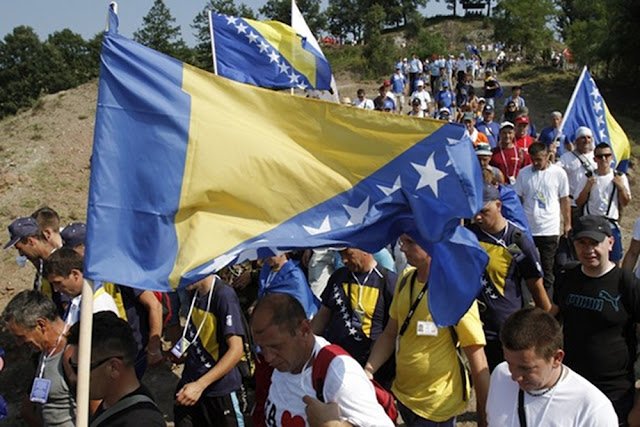This year marks the 20th anniversary of the beginning of the Bosnian war, as well as the 17th anniversary of the Srebrenica Genocide. On July 11, 1995, over 8000 Bosnian Muslim men (known as Bosniaks) from this town – what was supposed to be a safe haven protected by the U.N. – were killed by Bosnian Serb forces led by Gen. Ratko Mladic, currently on trial for war crimes at The Hague.
Every year, thousands of people from around the world gather in Srebrenica on July 11th to commemorate the men killed, as well as to bury those whose remains have been found. But starting on the evening of July 7th, many gather in a town called Nezuk to prepare for the start of the Srebrenica Peace March on the morning of July 8th. This is a three-day trek through heavily forested and mountainous terrain that marks, in reverse, the path taken by a group of Bosniak men who attempted to find a way out of Srebrenica and certain death at the hands of Bosnian Serb forces to safe, Bosnian-held territory.
I joined the Peace March participants in Nezuk on the morning of July 8th. For the next three days, we made our way to Srebrenica, stopping at night to rest in camps. There were many people from all over Bosnia and around the world who were there to take part in a journey that gave us a small sense of what it must have been like for these men, who had been shot at and targeted for death by Bosnian Serb forces while they sought to save their own lives.
It was a gruelling trek, not one meant for the faint of heart or those not physically and mentally prepared to take part in it. And yet participants included the young and the old, ranging in age from four to late-seventies, healthy individuals and those with physical impairments and health issues. All of those present were there primarily to pay tribute to the men who were killed in Srebrenica 17 years ago.
For Muhamed Omerovic, this was his eighth time participating in the Srebrenica Peace March. Mr. Omerovic has taken part in this pilgrimage every year since the first time the march was established in 2005.
Mr. Omerovic also has the distinction of being a survivor of the death march of 1995. He was amongst the men who fled Srebrenica on foot to escape death. Mr. Omerovic described this journey as 7 days of hell. From July 11 to 17, he made his way through this merciless terrain, barely escaping death while Serb forces shot at and lobbed shells towards him and his peers.
“Those were the darkest days of my life”, said Mr. Omerovic. He was fortunate for the fact that he was in the front of the column. This ensured better chances for survival, as Bosnian Serb forces focused on killing men who were at the rear.
Fellow death march survivor, Suljo Cakanovic, lost his brother and nearly 50 relatives.
“There’s no one left. I have no one left to turn to, no one to rely on. Out of my entire family, I’m all alone”, said Mr. Cakanovic.
Mevludin Hrnjic lost his father (who was taken away right in front of Mr. Hrnjic‘s mother), as well as three brothers and a brother-in-law when Srebrenica fell to Bosnian Serb forces. In addition to numerous members of his extended family, Mr. Hrnjic also lost an uncle, who was locked into a house and burned alive during the war.
“We’re people who take our yearly vacations during the period of the Peace March and burial (on July 11th). This means that we don’t take yearly seaside vacations, for recreational purposes. We dedicate our vacation time towards the burial and paying our respects to our people”, said Mr. Omerovic. Since July, 1995, he and others mark their calendars based on the Srebrenica Genocide commemoration and preceding Peace March. It’s an indication of how profoundly these people’s lives have been marked by what happened to them 17 years ago.
All of these men described mixed feelings regarding the Peace March. They were all grateful that so many people came from around the world to pay their respects to the fallen men of Srebrenica. But this event also brings back a lot of painful memories.
And they all express anger over Serbian president Tomislav Nikolic’s denial that what occurred in Srebrenica in July, 1995, is genocide.
But the fact that 5,500 of us were gathered together for the Peace March is testament to the fact that the world will never forget Srebrenica, or doubt for a second that what happened there was genocide.
Suzana Vukic writes a column for The Hudson/St.Lazare Gazette. She is also a freelance journalist who reports extensively on the Balkans and an honorary board member of the Institute for Research of Genocide Canada (IGC).



